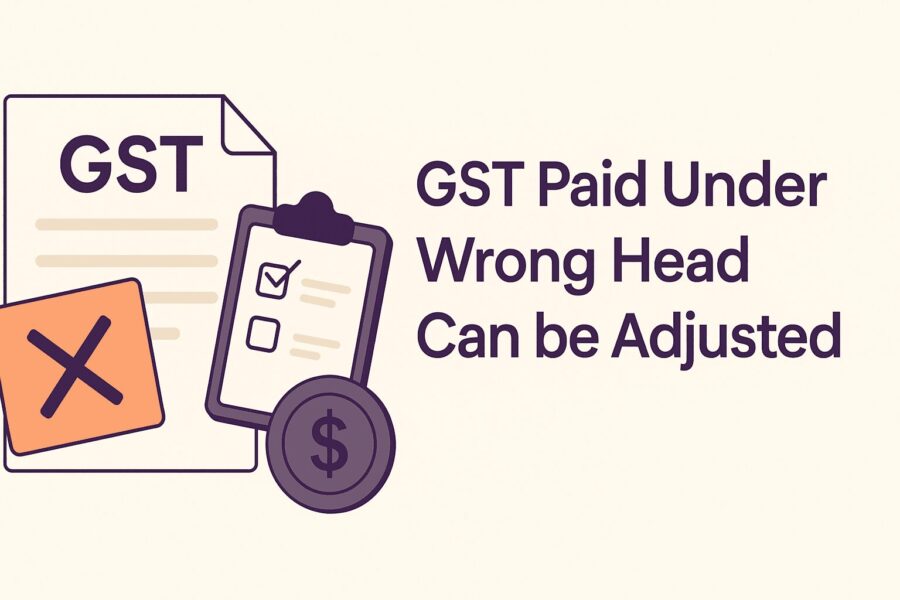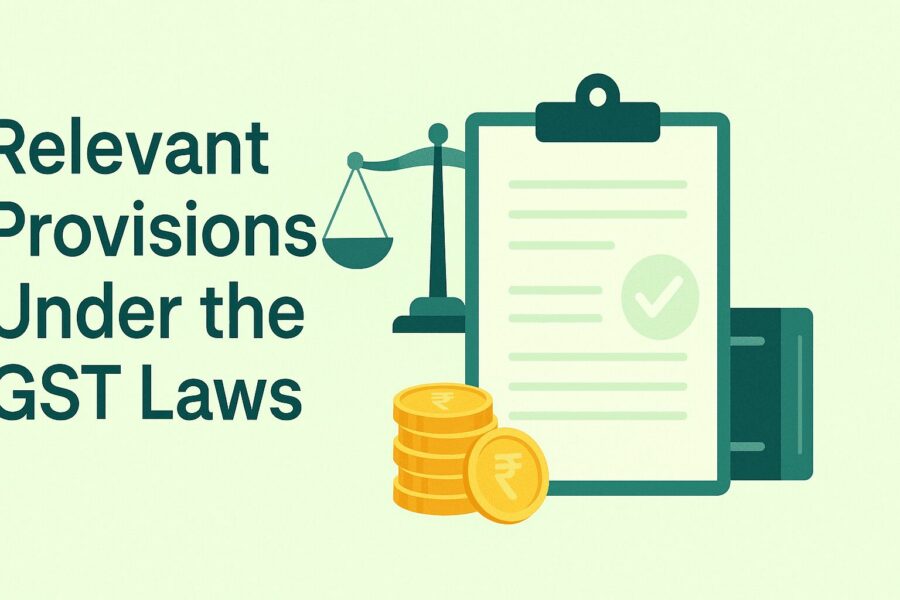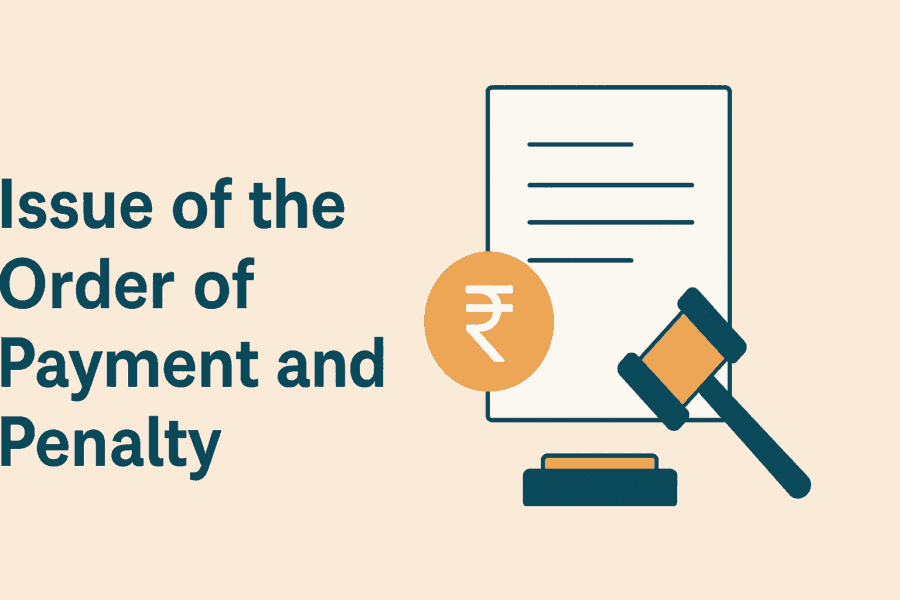GST Paid Under Wrong Head Can be Adjusted
- 16 Apr 25
- 8 mins

GST Paid Under Wrong Head Can be Adjusted
- Relevant Provisions Under the GST Laws
- An Amendment Introduced Under Relevant Provisions
- Impact of the Amendment
- Clarification on the Interpretation Issues
- When Tax Is Collected But Not Deposited with the Central Government or State Government
- Issue of the Order of Payment and Penalty
- Surplus Payment of GST
- Conclusion
Key Takeaways
- Wrong GST head? File a refund via Form RFD-01 within 2 years.
- No interest or penalty for genuine GST payment errors.
- Sections 77 (CGST) & 19 (IGST) govern such refunds.
- New rules clarify refund timelines post-2021 amendment.
- Self-identified or officer-found errors—both are eligible for a refund.
Taxpayers might pay Goods and Services Tax (GST) under the wrong head. Integrated GST (IGST) applies for inter-state transactions (transactions between two states), while CGST and SGST apply for intra-state transactions (transactions within an Indian state).
However, taxpayers might pay IGST instead of CGST and SGST/UTGST (Central/State/Union Territory Goods and Service Tax) or otherwise.
Here is how GST paid under the wrong head can be adjusted for tax compliance.
Relevant Provisions Under the GST Laws

IGST applies to inter-state supplies. If a taxable person collects CGST/SGST (Central Goods and Services Tax/State Goods and Services Tax) for an interstate transaction instead of IGST, he/she has to pay IGST and collect a refund of CGST/SGST.
CGST and SGST apply for an intra-state supply. If an individual collects IGST for an intrastate transaction instead of CGST/SGST, he/she has to pay the correct CGST/SGST and claim a refund of IGST. Notably, CGST and SGST are payable to both the Central and State Governments.
No interest will be applicable for wrong payment or inaccurate tax liability. Further, no penalty will apply to such a scenario. The GST authorities declared that businesses like the SMEs might make such mistakes with limited resources.
However, charging interest and penalties would create a challenging scenario for them. As a result, to simplify compliance regulations, the GST authorities do not charge any interest or penalty for wrongly collected IGST, CGST or SGST.
While Section 77 of the CGST Act, 2017 regulates CGST and SGST/UTGST payments, Section 19 of the IGST Act regulates IGST payment for an inter-state transaction of supply. Rule 89 of the CGST Act regulates refunds of excess tax paid by a registered person. Notably, the person paying excess tax needs to claim refund in Form GST RFD-01 within 2 years from the date of payment of tax.
An Amendment Introduced Under Relevant Provisions
The due date for applying for a refund of tax paid under the wrong head has been amended. The amendment has been enforced by inserting a new sub-rule (7) under Rule 89 of the Central Goods and Services Tax Rules (8th Amendment), 2021.
It states that refund claims need to be raised within 2 years from the date of the mistaken tax payment, after the enforcement of the rule.
Impact of the Amendment
Prior to the amendment, taxable persons paying GST under the wrong head have been subject to ambiguity pertaining to the correct time period for refund. However, the amendments clarified that taxable persons can raise refunds within 2 years from the date of paying GST under the wrong head.
In addition, if taxpayers paid GST under the correct head prior to the amendment notification, they could raise refund claims within 2 years from the date of the release of the notification. As the notification was released on 24th September 2021, taxpayers could raise claims until 23rd September 2021.
Clarification on the Interpretation Issues

Here are the clarifications pertaining to doubts about the tax paid under the wrong head:
● Initially a doubt persisted among taxpayers related to the term 'subsequently held'. Taxpayers questioned if the tax paid under the wrong head would be eligible for a refund if the tax officers identified it or if taxpayers identified it themselves. Circular number 162/18/2021-GST, dated September 25th, 2021 clarified that in both cases refund claims will be eligible.
● Taxpayers questioned that the amendment specified refund claims under Section 77. However, it did not specify the refund claim cases covered under Section 19. The tax authorities clarified that Rule 89(1A) would apply to the latter section wherein the taxpayer initially pays IGST on a transaction that is later determined to be an intra-state supply. In such cases, the taxpayer must subsequently pay the correct taxes, CGST and SGST, for the same transaction.
● The GST authorities additionally clarified that Rule 89(1A) would apply to refund applications filed prior to the notification, irrespective of whether they are pending or disposed of.
● If taxes paid under the wrong head are adjusted with the issuance of credit note as per Section 34 of the CGST Act, followed by the issuance of a tax invoice later charging tax, the refund rule under Section 77 would not apply.
● For specific scenarios, CBIC provided the below-mentioned details:
| Issuance Date of Invoice Charging Tax Under the Wrong Head | Various Scenarios | Date of Tax Payment Under the Correct Head | Due Date of Filing the Refund |
| March 10, 2018 | The taxpayer himself found that the tax was paid under the wrong head | May 10, 2021(prior to the issuance of notification) | September 23, 2023(2 years from the date of notification) |
| March 10, 2018 | November 10, 2021(after issuance of notification) | November 9, 2023(2 years from the date of tax payment under the correct head) | |
| March 10, 2018 | Proper officer or adjudication authority or appellate authority subsequently held that tax is paid under the wrong head | May 10, 2019(before notification issuance) | September 23, 2023(2 years from the date of notification) |
| March 10, 2018 | November 10, 2021(post-issuance of notification) | November 9, 2023(2 years from the date of tax payment under the correct head) |
When Tax Is Collected But Not Deposited with the Central Government or State Government
The GST laws mandate depositing collected CGST, SGST and IGST with the Centre or State Government, as applicable. Even if a supply is non-taxable and GST has been collected on the same, it needs to be deposited with the respective government.
As a result, taxpayers cannot collect GST and later raise a claim that the goods and services are exempt, to avoid depositing tax with the GST authorities. If such a scenario occurs, the GST authorities levy a penalty on the taxpayer.
The proper officer issues a show-cause notice for a penalty payment. Notably, the concerned taxpayer enjoys an opportunity for a hearing before they pay the penalty.
Issue of the Order of Payment and Penalty

Here is the process to issue an order for overdue tax payment and penalty:
● The proper officer issues an order wherein the taxpayer has to pay the due tax amount, in addition to the penalty.
● This person has to pay the collected GST, interest and late payment fee.
● The interest period includes the tenure between the date of tax collection and tax payment at a given rate.
● A proper officer needs to issue the order within 1 year from the date of issuing the show cause notice.
● If a Tribunal or court issues an order, the period might vary from the usual 1 year tenure.
Surplus Payment of GST
If there is any surplus payment with the GST authorities in relation to a specific taxpayer, the authorities will refund the same to the concerned taxpayer. Alternatively, the GST authorities might credit the excess amount to the Consumer Welfare Fund under GST. The buyer can apply for a refund within 6 months from the date of public notice issuance.
Conclusion
GST paid under the wrong head can be adjusted if the taxpayer claims refunds of the incorrect GST payment. The time limit for raising refunds is 2 years from the date of tax payment for adjustment of tax paid (tax adjustment).
Notably, irrespective of who detects GST payment under the wrong tax head such as the taxpayer himself or the proper officer, the taxes paid can be adjusted with Form GST RFD-01 under the correct tax head.
💡If you want to streamline your payment and make GST payments via credit or debit card or UPI, consider using the PICE App. Explore the PICE App today and take your business to new heights.
 By
By 
















